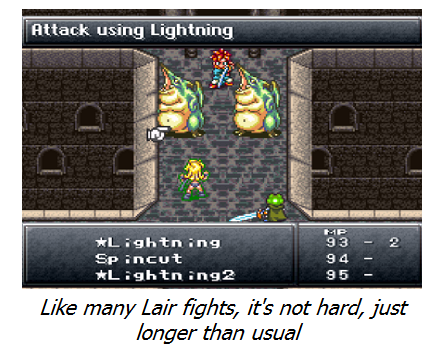Chapter 3: Quests Nine through Twelve
Quest 9 - Can't Stop the Dungeons
Stat of the Quest:The Tyrano Lair features, effectively, the biggest disparity between the HP of the final boss and the HP of the weakest enemy. The Volcano has a perfectly reasonable amount of health for an enemy in the low level-20 range, and not that much less than the average enemy in the Tyrano Lair. Yet that enemy has only 1.9% of the health of the Azala/Tyrano combo. This is a great illustration of how long the Tyrano fight is supposed to feel, as a precursor to the relief that quest 10 affords.
(Some provisos apply to the stat: we discount the enemies that have 10 or less HP as they unanimously have gimmicky defenses that belie their HP totals. We also discount the Decedents in Magus� Castle, because as we pointed out in quest 8, they�re from an earlier quest, and are supposed to be cannon fodder for your tech points.)
Quest 9 continues the relentless pace of dungeon content carried over from quest 8. There are new bits of NPC chatter, but of the 10 new pieces of chatter, 8 are exceedingly obvious direction toward the Tyrano Lair. There are some new weapons to be bartered for, but no new armor. Basically ,there�s nothing meaty in between the player and the next dungeon sequence. What makes quest 9 feel so long is that the intercalary section--the Dactyl Nest--that precedes the Tyrano lair is long and filled with numerous unavoidable monsters, 2/3 of which will continue appearing in the next dungeon! It�s basically the same as the Lab 16/Info Center divide.
The battles in the Tyrano Lair are smaller, though, than those in Magus Castle. The average number of enemies per encounter in the Lair is just over two and the largest battle is four enemies, while at the Castle the average number is just under four and the largest battle is six enemies. Enemies in the Tyrano lair mostly die easily, too, and so don�t require a party composed around multi-targeted dual techs. Part of the reason for this is that Ayla doesn�t have a lot of multi-targeting dual techs at all, much less at this point time; she�s probably gained less than 100 total tech points. Another reason is that this dungeon isn�t supposed to be hard, it�s just supposed to feel long. We�ll see why that�s the case with the Azala/Tyrano fight at the end.
There are a couple of important triggered vulnerability dinosaurs running around. The Terrasaur is almost like a boss in how much HP it has relative to normal enemies, plus its strong defense. The player will be spending a lot of Crono�s MP on exploiting the lightning-induced triggered vulnerability. Even more than the Terrasaur, the big challenge for the first part of the Lair is Nizbel 2. Nizbel 2 is quite a bit like Nizbel, but the triggered vulnerability has been tuned up: he�ll regain his defense after every attack--it�s a natural step in the progression of triggered vulnerability, a progressions which will culminate in the Retinite.
The Azala/Tyrano fight is a little bit strange when compared to most of the other fights in the game. It is a two-phase fight, like the encounter with Magus; and also like that previous battle, the second phase is designed around wipeout attacks. In the only example of this in the entire game, phase one of the fight (Azala) is weak only to magic, while phase two is vulnerable to anything. Phase one is about attrition attacks, and phase two is about a big, fire-based wipeout attack. The strange thing about this attack--and really, the battle--is that it�s on a clearly delineated timer; what�s there to fear in a wipeout attack that comes slowly and obviously? The designers were not fools, however; the point of the Tyrano�s fire breath is to force the players to stop dealing damage and heal. This, combined with the Tyrano�s massive amount of HP (over 10,000) means that this fight is going to go on for a good long while. That long duration, however, is the whole point!
After two back-to-back dungeons, a series of long boss fights, and a couple of big plot twists, the player would be right in feeling worn out. The long--but not particularly dangerous--Azala/Tyrano fight is just the final piece in the exhaustion the designers are trying to make the player feel. The well-constructed pacing of the game is going a little awry. But that is where one of the best quests of all time comes in, and one of the most ingenious surprises in all of gaming.
Quest 10 - How did we Get Here?
Stat of the Quest:It�s more of a list, really, but here are the 5 most crowded town screens in the game. (1) There are 24 people in Zeal Palace�s main room (2) 12 in Enhasa (3) 12 in Earthbound Commons, (4) 11 in Kajar�s main room, (5) 11 in modern Guardia Castle. It certainly highlights part of the reason Zeal feels so magnificent and surprising, doesn�t it? It also explains why it�s so easy to spend time talking to all of these people; you don�t have to dig around to find them.
Quest 10 is easily the game's most brilliant quest; it's arguably one of the best quests in any RPG ever. Yet, in order to understand why this quest is so brilliant, we have to understand its place in the greater order of the game. So, for a moment, we're going to take a break from our examination of individual quests and see the bigger picture of Chrono Trigger. We'll look back at the quests that led up to this point to see how the overall pacing of the game makes this quest possible--and special.
Below is a diagram I call an amplitude map. The point of the amplitude map is to measure how two different--usually contrasting--game design elements are balanced in a level, quest, or section of a game. The contrasting elements in Chrono Trigger are combat and exploration. Combat is more or less what you would expect; the number of enemies in a given quest have been counted up (including bosses, which are weighted) and that number is used as a score, which is visually represented on the bottom, in quest order. Exploration is a little more complex; the exploration score for a given quest is made up of newly available NPC chatter, slightly weighted so that NPCs the player has never met are scored slightly higher than NPCs the player has met, but who have new dialogue. Players tend to favor new NPCs over old, as many old NPCs have the same old dialogue throughout the course of a JRPG. Lastly, any treasure chests available outside a dungeon are counted up and added to the exploration score. (In-dungeon chests are not counted as they're almost always right in front of the player's face and they almost always require combat.) Over each quest is a total amplitude score, which combines the scores of the exploration and combat sections, giving us a final measure of how much content there is in each quest.
With this perspective, we'll do a quick recap and analysis. Quest one features a lot of of exploration and a fairly large dungeon and has a total score of 117. This makes sense, design-wise; it's better to begin a game with a bang, so to speak, than to start too slowly. Quest two slows down a lot, and only has a score of 30, if you count the three questions asked at trial in the exploration score. We already examined how quest 2 does a lot of deceptive things to mislead players about what kind of game they're playing. That's an important little trick, but it's a pretty brief quest--especially if Lucca rescues Crono. Quest 3 (amplitude 65) is a bit bigger, having two locations of new NPCs and a decent number of combat encounters across the two segments of its dungeon. Quest 3 needs to be big, in order that the revelation about the "Day of Lavos" feels climactic. It works fairly well in that regard. Quest 4 (amplitude 33) is slightly smaller because there is almost no exploration to be done at all. The bike race is a brief and rather tedious distraction, but it certainly doesn't have the player exploring anything.
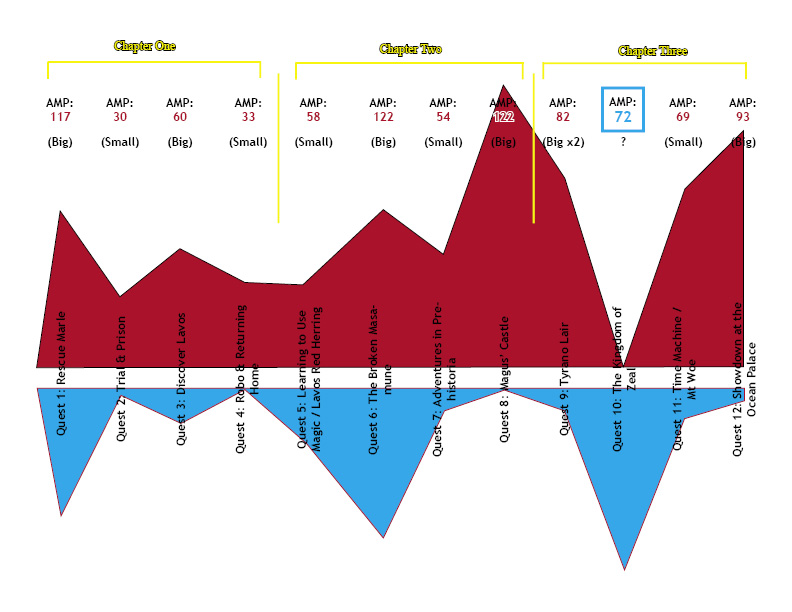
The amplitude measurement of the first four quests is: 117, 30, 65, 33, in that order. Or, if you will, a big quest, a shorter quest, a big quest, a shorter quest. That's pretty standard videogame pacing for a console game (as opposed to an arcade game). The player may not have noticed the pattern yet, but they will.
Next is the introduction to the larger game mechanic of surfing through time via the End of Time, which resets the �chapter� pattern. The player also acquires magic here, and has to split the party. It's the first real turning point in the game's pacing, and it restarts the cycle of small and large quests. It starts with a smaller quest, reversing the order so that the projected finale of this chapter will be a big quest rather than a small one. Quest 5 (amplitude 58) is a fairly short, fairly straightforward quest. All the exploration we missed in quest 4 is made up for in Medina Village. The Heckran Cave is a bit tricky to new players as they learn to ration their magic, but it's not a long dungeon by any means. Quest 6 (amplitude 122) is huge, larger than anything we've seen so far. That makes sense; quests ought to get longer and more challenging as the game goes on. But it's not just dungeon content; there are a lot of new NPCs to speak to in Dorino and Porre. And a lot of the old NPCs have new things to say. The first really tough boss is found at the end of this quest.
Quest 7 (amplitude 54) is smaller, especially as it comes to NPCs. The dungeon is fairly long, but there isn't a lot of NPC chatter. (Even during the festival, all the NPCs share only a few lines of dialogue. It's pretty boring.) It should be fairly clear that the showdown with Magus is going to be coming soon, so it makes sense that this quest would be a little bit smaller. By now, the player should really be "feeling" the rhythm of the quests, expectant and eager for the next big thing. Quest 8 (amplitude 122) is exactly as climactic as the player expects. The amplitude isn't higher than quest 6, because there's virtually no exploration. (I count bringing Frog to Spekkio as exploration, because that is an exploratory duty, and if you don't do it, you're totally boned.) But that dungeon is enormous! It's even bigger than Ozzie said it was going to be! And there's the big reveal: Magus didn't create Lavos. A really good dungeon makes plot reveals so much sweeter, doesn�t it?
Quest 9 (amplitude 82) breaks the pattern! We've seen two small quests back to back, but that's very different from two large back-to-back dungeons. Plus, those other two quests (4 and 5) were broken up by the visit to the end of time. And quest 5 had all the exploration that quest 4 was missing--but that's not the case in the transition from quest 8 to quest 9. No matter how you look at quest 9, whether as a part of the second "chapter" or the third, there's no more pattern. There should be some kind of break between Magus' Castle and the consecutive Dactyl Next/Tyrano Lair, right? There should be at least a little exploration before the player is back to grinding through dungeon content. Something weird is going on here. Take a look back up at the whole pattern to see what we're talking about.
And this brings us to quest 10, which is the game's most brilliant. What is the quest objective? There isn't one explicitly stated. What is the dungeon? There isn't one! How many mandatory battles are there? None, until the boss at the end. How many mandatory, scripted story segments are there? None, until the very end! Quest 10 gives players a full 20-25 minutes to do nothing except explore the Kingdom of Zeal, talk to its citizens, search for secrets, collect a few treasures, and hear a whole lot about a mysterious pendant and all the special places it's connected to. In fact there are 11 NPC allusions in Zeal, most in the game; that counts for 40% of all the game's allusions. In most cases, however, the player won't realize the meaning of the allusion until after the Mammon Machine charges up the pendant.
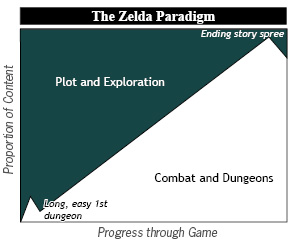
The player has been set up to expect something completely different from Zeal by the pacing of the game. As the dungeon content ramps up through Magus' Castle and the Tyrano Lair, it would make a lot more sense for towns and NPCs to start playing a much smaller role in the game. This would be especially true for players who have a lot of JRPG experience. The usual JRPG formula is smaller, easier, fewer dungeons up front, with lots of towns and fun little exploration quests. Later in the game, it�s supposed to be more dungeons, longer dungeons, and fewer breaks in between. This all started with Zelda games, whose 3-dungeons-to-7-dungeons formula worked so well for so long.
Squaresoft games of the 90s always played with this formula. Final Fantasy 5 pushed the tapering of town sections back by having three world maps. Final Fantasy 6 afforded so much freedom (and a decent amount of variety) that it was hard to discern that the game�s focus on content had changed--although it definitely did. But no game of the 90s ever gave players the biggest pure exploration section of the game smack in the middle of it! Chrono Trigger does, and what a surprise it is.
Technology has marched on, and so the graphics of Chrono Trigger are dated, but there�s also a lot of neat things that the game did with its art in Zeal that help to embellish this effect. First off, notice how ornate the tileset for Zeal is. The quality of the pixels and colors aren�t necessarily any better, but the amount of decorative detail on the objects has gone up. For example, see these beds and counters from other times, and then see in Zeal how there are intricate patterns on both instead.
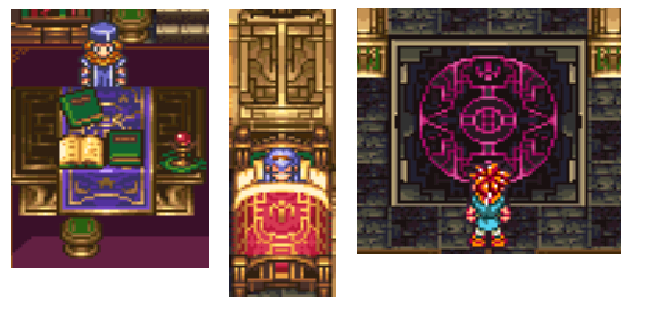
Even the wall panels are elaborate and frequent. There are wall decorations in other eras, but none of them have the little details that Zeal does. Look at Kajar, where the crest of Zeal is everywhere. It foretells a major story point: that the sealed doors and chests originated in this era!
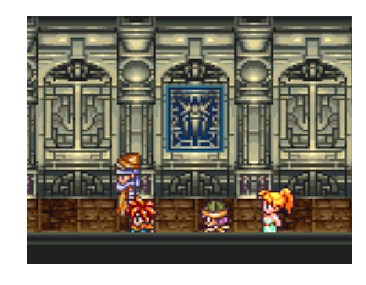
Or even look at the way that non-explorable space is lit up. Usually this space is black and cold and meant to be overlooked, but in Enhasa the artists even used this empty space to capture the ambience of the soft golden light that shines on Zeal.
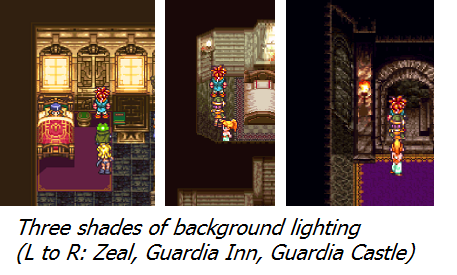
It�s not just stylistic art touches, either; there are small symbolic details in Zeal that aren�t present anywhere else. For example, in the entire rest of the game (besides Zeal) there are only 11 bookshelves--all of them in a meaningful place. Crono owns one, because he�s the awesome hero, right? Lucca owns two, because she�s the world�s foremost inventor. The Cathedral has three, which makes sense, since that�s the center of scholarship in a medieval society. The Mayors of Dorino and Porre each have a bookshelf to reflect their status. Melchior has two, because he�s a sage. Also, for whatever reason, the carpenter in 600 AD Choras has one; I guess he�s doing well.
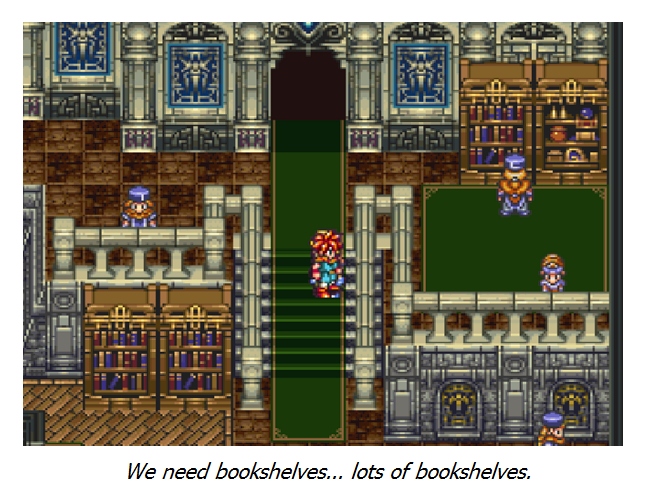
In total, that�s eleven bookshelves across several different eras, geographical regions, and kinds of characters. Zeal has eighteen bookshelves. It�s a rather intuitive and subtle touch, isn�t it? Books to symbolize knowledge and splendor. That�s what Zeal is supposed to be about: a lost civilization that possessed knowledge of magic and the elements. It�s not likely that players will consciously say, �Oh wow, bookshelves!� but it�s likely that along with all the other small touches like the magical astrolabes and assorted enchanted knickknacks of Zeal, the player is going to come away with an impression of magnificence.
All of this splendor culminates in the introduction of Schala, Dalton and Zeal. Dalton and Queen Zeal are the foes we never see coming. Neither one is particularly well developed, but whereas most of the other villains in the game have been ready to take a crack at the party, both Zeal and Dalton would much rather avoid confrontation if possible. They�re both banking on a haul of magical energy that will make them immortal, a kind of cult-of-Lavos attitude that is new. Accordingly, Zeal will send Dalton to fight, Dalton will send Golems to fight--and he will flee if he�s losing. It certainly makes for a refreshing change from the fatalist Azala or cryptic Magus, although both those enemies were cool while they were on screen.
Schala, on the other hand, is a figure who instantly and thoroughly embodies a tragic mood. Consider the first conversation we hear: (1) She agrees with Janus� sense of impending doom. (2) Her first impulse is to protect him. (3) She loves him but has to go be a dutiful daughter. (4) She seems to be genuinely interested in the party. (5) She apologizes to a servant. Add to all this the beautiful but elegiac music that plays when she�s introduced, and she might as well have crosshairs painted her forehead; she�s way too nice for this game. Older first-time players are going to catch this drift: things are about to get tragic.
Last is the Golem, of which the player will eventually fight four. The Golem is a kind of elite abstraction on the theme of triggered vulnerability; he�s definitely the most complicated boss (though not necessarily the most difficult) that the party has faced yet. It�s not that he is immune to physical damage. You can hit him with physical attacks; it is just very dangerous. The problem is that the player needs to hit the Golem with weak physical attacks as though he were a triggered-vulnerability enemy, but in reverse order. His physically-triggered attack is easily enough to totally punch out a character at the appropriate level. His other attacks are largely attrition-oriented, especially the HP-halving Iron Orb. With Ayla in the party, there are a lot of new, high-powered physical dual techs that would work great, so players might really want to abuse them. That�s exactly why the Golem is tricky the first time through, and why the fight is memorable for first-timers.
Quest 11 - And Back Again
Stat of the Quest:This graph shows EXP per battle across the course of the game. Although the Tyrano Lair was a long time ago, the player�s EXP needs haven�t actually grown--there�s no corresponding spike in EXP needed. So when the player gets hit with a surge in character levels, they�re going to think that something major about the game has changed. And it has! The game is moving towards the conclusion of the Tragedy.
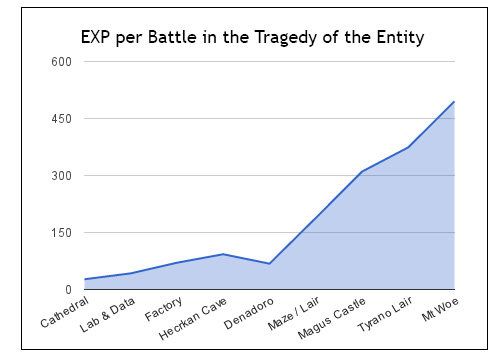
If there is one major flaw with Chrono Trigger, one that stands above the rest, it is the confusing direction that sends the player to the Keeper�s Dome (where Balthasar has been) at the beginning of quest 11. Many first-time players will not have noticed the southern stretch of land in 2300 AD, nor the Sewer Access tunnel that leads to it. So when the game displays a screen of the point that the player is �supposed� to have visited before, newbies might simply say, �What the hell are they talking about?� True, some more astute observers might figure it out pretty quickly, but even if a sizeable minority of the players are baffled, it�s way out of line with the rest of the game. Chrono Trigger quests have been tight, well-organized, and usually very clear about what must be done. The beginning of quest 11 is the worst Chrono Trigger has to offer in that regard. That said, it�s not too terrible; after enough fumbling most players will find where they need to go. It could just be a little more obvious. What saves the game is that this is an individual problem rather than a systemic problem--it doesn�t affect any other part of the game.
As a side note, it should be mentioned that the player now has access to virtually every sealed door in the game, and every sealed chest. This makes the end of quest 10 or beginning of quest 11 a very good time to grab some loot. It makes the most sense to append this exploration period to the end of quest 10 since they�re all about the same thing.
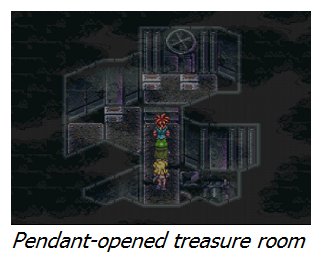
The NPCs in Algetty offer a little bit of backstory on the dirty underbelly of Zeal, but there�s really nothing stopping the player from heading straight to Mt Woe.
The Beast Nest / Mt Woe offers a slightly abnormal two-boss two-part dungeon. The parts don�t break down neatly; most of the content comes after the first save point. The enemies are mostly pretty simple, no tricks of triggered vulnerability or comprehensive elemental absorption. Although the Bantam Imps have a second form after they�re hit for a bunch of damage, the player�s strategy doesn�t need to change. The Gargoyle enemy has a tough attack that reduces party members� HP to one, but they very rarely use it on the first turn. The Man Eaters, which aren't that powerful, can cause the Chaos status debuff. All of these enemies have bizarrely low HP, however, making them quite easy if a party member can get off any kind of multi-target attack.
In fact, this dungeon seems very odd from a statistical standpoint; everything is ramping up conspicuously, except the difficulty. Almost all of the enemies on Mt Woe have less HP than their counterparts in the Tyrano Lair and even Magus Castle. It�s really easy to kill a lot of them very quickly, yet the EXP flows in great quantity. Like it says in the headnote to this quest, EXP per battle is a good way to measure this change. With all the multi-targeting dual techs available, players will be able to finish encounters in one or two rounds, no matter how many enemies there are in an encounter. Because of that ability, most battles (regardless of number of enemies) take the same amount of time, on average. Therefore, the amount of EXP per battle is probably the best way to measure the rate of earned EXP. On Mt Woe, even though the player�s EXP needs haven�t grown substantially, the average EXP per battle is about 800. (If you count the optional Rubble enemies, the average is 855.) The same is true for tech points: the previous two dungeons offered an average of 8.3 and 9.3 tech points per battle, respectively. Mt Woe offers 25 tech points per battle.
A lot of easy encounters resulting in a large amount of EXP and tech points means that players will feel the game is, perhaps, winding towards something big--although with all the false climaxes who knows what this might be? The presence of the Rubble enemies--difficult enemies with a limited kill-timer--heightens this effect. Even new players can�t escape the feeling that they�re getting into the thick of the game, and that something important must be approaching. (We�ll hear a lot more about this, next quest.)
For all the easy enemies and their plentiful rewards, the bosses are big, mean and tricky. This is less true of the Mud Imp and his beasts than the Giga Gaia, but both have their quirks. The Mud Imp is yet another three-part boss (as is Giga Gaia). The two beasts have the elemental affinities anyone might guess. The Mud Imp himself is highly resistant to physical damage, and periodically heals; that�s about it. The Giga Gaia, on the other hand, will kill new players at least once, probably twice or more. Giga Gaia is actually just a pumped-up version of the Guardian boss from much earlier in the game, complete with 3-part design and severe counterattack.
Attacking the main body while the two extra parts are alive will result in a severe counterattack that can instantly wipe out lower-level parties, and severely hurt even well-tuned groups because it can come twice in a row (for a total of four ~120 damage attacks to everyone). That�s the only trick, but it�s a heck of a trick. The only added difficulty is that sometimes the arms will revive right before an attack is launched, resulting in that nasty counter. Getting the strategy and timing right isn�t too hard, but after a few game overs, it�s a very satisfying victory.
Quest 12 - The Climax of the Tragedy
Stat of the Quest:Turning point! By the end of this quest the player will have fought very close to 75% of the battles in the game. On the other hand, they�ve only fought 46% of the bosses. (And they�ve only earned about 32% of the EXP, assuming they fight every battle in the game once... which is, admittedly, unlikely, but it�s a good measure.)
If you hold at all to the notion that Chrono Trigger is, in some regard, two distinct games, then quest 12 is the climax of the first game. Even if you don't really buy into that view of the game, the party's confrontation with Lavos at the bottom of the Ocean Palace might still qualify as the pinnacle of the game's action. And what a climax it is! Square's designers and artists did all of the little things right in building it up. The new save point inside Zeal Palace, the two sets of flanking guards that wait outside the throne room. The boss fight against Dalton to gain entrance. The beam that teleports the players to the massive, mysterious structure beneath the waves--we've never seen something like this happen on the world map before. It's new, it's exciting, it's ominous.
Once inside the Ocean Palace, the trend of seeing new things continues. Immediately we start seeing all kinds of little design touches that distinguish this dungeon from the rest of the game. Masa and Mune appear at the entrance to each section, warning the party of the dangers ahead. There's that music--dire, percussive, heavily orchestrated. Remember how simple the theme for Magus Castle was? The Tyrano Lair's heavy, loud theme was remarkable, but it was a slow groove and had its quiet moments. But the Ocean Palace holds nothing back--and it doesn't stop during most battles! It's not the first time this has happened, but it definitely makes an impression.
Another subtle marker indicating the climax to come is the presence of all manner of new enemies. The Ocean Palace introduces four entirely new sprites: the Scouts (Flyclopses), Lasher, Thrasher, and Mage. Lashers, Thrashers and Scouts can perform proper double and triple techs--something we haven't really seen before in normal enemies. (The Acid/Alkaline enemies could do a pale imitation called "Fusion"... but Scouts can cast Delta Force!)
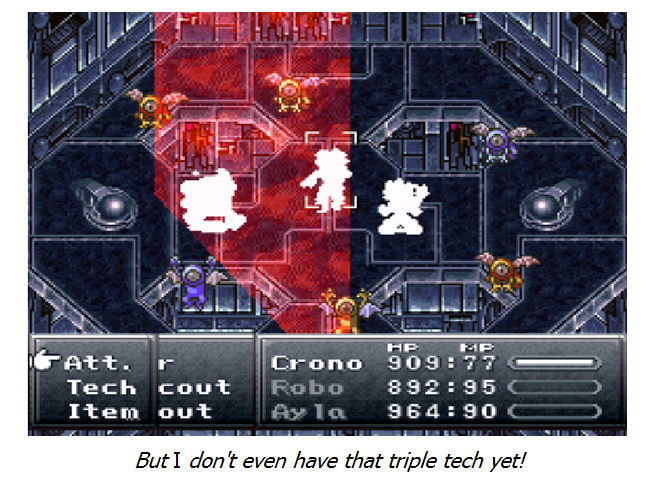
Moreover, Scouts all have a variety of elemental weaknesses, so forget about using those multi-target elemental spells. Mages can--and frequently do--cast status debuffs. The Jinn/Barghest combo too presents a new kind of triggered vulnerability via shielding unit.
The Ocean Palace also has a lot of really strong gear available in treasure chests. Magus Castle threw 7 pieces of gear at the party, as well as a bunch of consumable items. The Ocean Palace provides the party with 8 new pieces of gear, but only one consumable item--an Elixir which comes last. It's not that much more gear than other dungeons, but because the flow of gear is never interrupted by a Mid Tonic or a Shelter, it feels like an awful lot. Additionally, the gear is quite powerful. That Aeon Suit and Aeon Helm are going to last a long time into free-roaming second game.
The best and most deceptive evidence suggesting that the climax of the game is soon to happen is the number of tech points the player has accumulated so far. Using RPG veteran expectations and the game�s own interface, the game can fool you into thinking it�s nearly complete! Even if the player has only fought every enemy in the game just once, Crono should be within 300 points of learning Luminaire. That means that the player has not done any extra grinding, any optional fights (like the Nu encounters), has avoided all fights the second time around--which is actually impossible in many cases--and has generally been very stingy about fighting. Even then, Luminaire is within reach. Twelve to fifteen battles in the Ocean Palace would make that difference up.
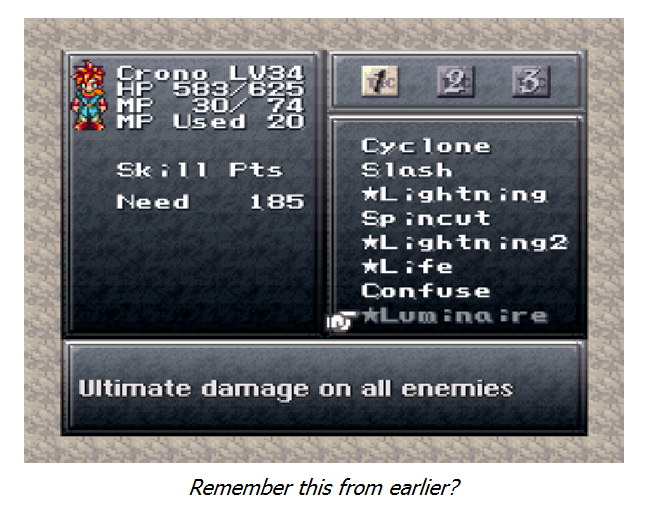
But if the player has done any extra work at all they�re going to have not just Luminaire, but also a lot of the available triple techs. Arc Impulse, Triple, Delta Force, Delta Storm and Fire Zone could all easily be in the arsenal, if you�ve been using the relevant third character. New players and experienced JRPGers alike would naturally expect that with little else to learn--what�s the rest of the game going to be about? It must be coming to an end. All of this is just a series of red herrings, though, designed to make the player expect something, and get something else.
A good tragedy typically requires a fatal flaw in its main character. It would be charitable to call Crono one-dimensional; he�s barely there as a person. But as an avatar that the player controls, and onto whom the player can project whatever they wish, Crono serves excellently. He is a JRPG hero, put into the game to let the player kill the bad guys. That is his purpose and his destiny.
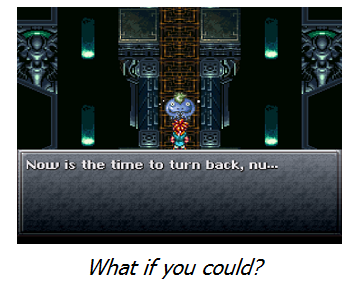
So the tragedy of Crono, his fatal flaw, is that he�s a videogame hero. He has no choice, except to kill the bad guy. That�s what he�s there for! Could you really take the Nu�s advice, turn around, exit the dungeon, hop back in the time machine, and spend the rest of the game milling about the world map--if you continue playing at all? No, of course you can�t. You the player, and your avatar Crono, are bound to face Lavos. The choice is no choice at all. It�s a fatal flaw not imposed by the story, not imposed by the characters, but imposed by the design of the game.
So when Crono stands up after Lavos defeats the party, it is inevitability in action. Even if the player has no way to beat Lavos, he has no other choice but to face Lavos. And so Crono is doomed, and the tragedy is complete. After his death the party is thrown out of the temporal rift. The pendant which has effectively steered the course of the game at all the right moments seems to be responsible for this, although we might as well chalk it up to the �Entity,� which has been putting on this play the whole time.
Next - Grim Resolution and a New Beginning: Quests 13, 14 and Fiona's Forest.
